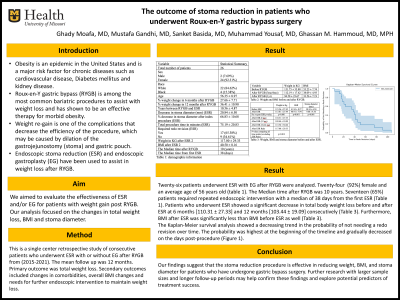Tuesday Poster Session
Category: Obesity
P4036 - Outcomes of Stoma Reduction After Gastric Bypass Surgery
Tuesday, October 24, 2023
10:30 AM - 4:00 PM PT
Location: Exhibit Hall

Has Audio
- GM
Ghady Ali Moafa, MBBS
University of Missouri-Columbia
Columbia, MO
Presenting Author(s)
Ghady Moafa, MBBS, Mustafa Gandhi, MD, Sanket Basida, MD, Muhammad Nadeem. Yousaf, MD, Ghassan M. Hammoud, MD
University of Missouri-Columbia, Columbia, MO
Introduction: Obesity is an epidemic in the United States; According to the World Health Organization, worldwide, there are approximately 650 million adults with obesity and 42 million children. Obesity is a major risk factor for chronic diseases like cardiovascular disease, Diabetes mellitus, and it’s complications of blindness and kidney disease. It’s also associated with cancers like endometrial, breast, and liver cancers. Bariatric surgery is invented in 1967 with loop gastroenterostomy; while Roux-en-Y gastric bypass is the most common procedure used and has shown effective therapy for morbid obesity, weight re-gain is one of the complications that decrease the efficiency of the procedure, which may be caused by dilation of the gastrojejunostomy (stoma). For which endoscopic procedure has been used for stoma reductions.
Methods: In this single-center retrospective study, consecutive patients who underwent stoma reduction after gastric bypass surgery were included. The primary outcome was total weight loss after stoma reduction. Secondary outcomes included changes in comorbidities including DM, HTN, HLD, and overall BMI changes and needs for more re-do of stoma reduction to maintain weight loss.
Results: A total of 27 patients were analyzed in this study, 93% of them were female with an average age of 57 years old. On average, patients performed the SR procedure 10 years after the GB. About 65% of patients required a redo revision.
Following the SR procedure, patients showed a significant decrease in both weight (p < 0.01) and BMI (p < 0.01) compared with the baseline values prior to the SR procedure. Moreover, there was a significant reduction in stoma diameter (30.34 vs 9.68; p < 0.01). Furthermore, when comparing patient weight before the procedure with the weight across multiple time points (before SR, after SR, 6 months after SR, 12 months after SR, 24 months after SR) we also found a significant decrease (p=0.013).
The Kaplan-Meier survival analysis showed a decreasing trend in the probability of needing a redo revision over time. The probability was highest at the beginning of the timeline (1.000) and gradually decreased on the days post-procedure.
Discussion: Our findings suggest that the stoma reduction procedure is effective in reducing weight, BMI, and stoma diameter for patients who have undergone gastric bypass surgery. Further research with larger sample sizes and longer follow-up periods may help confirm these findings and explore potential predictors of treatment success.
Disclosures:
Ghady Moafa, MBBS, Mustafa Gandhi, MD, Sanket Basida, MD, Muhammad Nadeem. Yousaf, MD, Ghassan M. Hammoud, MD. P4036 - Outcomes of Stoma Reduction After Gastric Bypass Surgery, ACG 2023 Annual Scientific Meeting Abstracts. Vancouver, BC, Canada: American College of Gastroenterology.
University of Missouri-Columbia, Columbia, MO
Introduction: Obesity is an epidemic in the United States; According to the World Health Organization, worldwide, there are approximately 650 million adults with obesity and 42 million children. Obesity is a major risk factor for chronic diseases like cardiovascular disease, Diabetes mellitus, and it’s complications of blindness and kidney disease. It’s also associated with cancers like endometrial, breast, and liver cancers. Bariatric surgery is invented in 1967 with loop gastroenterostomy; while Roux-en-Y gastric bypass is the most common procedure used and has shown effective therapy for morbid obesity, weight re-gain is one of the complications that decrease the efficiency of the procedure, which may be caused by dilation of the gastrojejunostomy (stoma). For which endoscopic procedure has been used for stoma reductions.
Methods: In this single-center retrospective study, consecutive patients who underwent stoma reduction after gastric bypass surgery were included. The primary outcome was total weight loss after stoma reduction. Secondary outcomes included changes in comorbidities including DM, HTN, HLD, and overall BMI changes and needs for more re-do of stoma reduction to maintain weight loss.
Results: A total of 27 patients were analyzed in this study, 93% of them were female with an average age of 57 years old. On average, patients performed the SR procedure 10 years after the GB. About 65% of patients required a redo revision.
Following the SR procedure, patients showed a significant decrease in both weight (p < 0.01) and BMI (p < 0.01) compared with the baseline values prior to the SR procedure. Moreover, there was a significant reduction in stoma diameter (30.34 vs 9.68; p < 0.01). Furthermore, when comparing patient weight before the procedure with the weight across multiple time points (before SR, after SR, 6 months after SR, 12 months after SR, 24 months after SR) we also found a significant decrease (p=0.013).
The Kaplan-Meier survival analysis showed a decreasing trend in the probability of needing a redo revision over time. The probability was highest at the beginning of the timeline (1.000) and gradually decreased on the days post-procedure.
Discussion: Our findings suggest that the stoma reduction procedure is effective in reducing weight, BMI, and stoma diameter for patients who have undergone gastric bypass surgery. Further research with larger sample sizes and longer follow-up periods may help confirm these findings and explore potential predictors of treatment success.
Disclosures:
Ghady Moafa indicated no relevant financial relationships.
Mustafa Gandhi indicated no relevant financial relationships.
Sanket Basida indicated no relevant financial relationships.
Muhammad Yousaf indicated no relevant financial relationships.
Ghassan Hammoud indicated no relevant financial relationships.
Ghady Moafa, MBBS, Mustafa Gandhi, MD, Sanket Basida, MD, Muhammad Nadeem. Yousaf, MD, Ghassan M. Hammoud, MD. P4036 - Outcomes of Stoma Reduction After Gastric Bypass Surgery, ACG 2023 Annual Scientific Meeting Abstracts. Vancouver, BC, Canada: American College of Gastroenterology.
